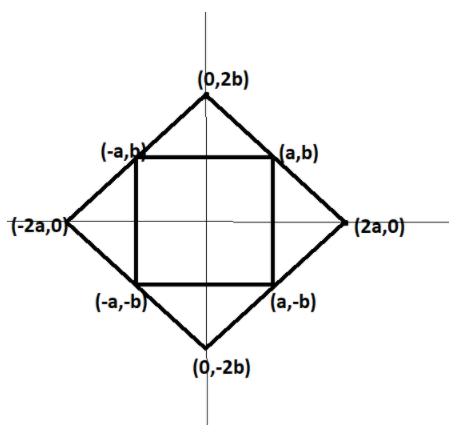
The coordinates for a rhombus are given as $(2a,0),(0,2b),( - 2a,0),and(0, - 2b)$ . How does one prove that the midpoints of the sides of a rhombus determine a rectangle using coordinate geometry?
Answer
534k+ views
Hint: The Midpoint Formula works precisely the same way as If you would like to search out the purpose that's exactly halfway between two given points, just average the x-values and therefore the y-values.
Complete step-by-step solution:
Let the coordinates of a rhombus as
$A(2a,0),B(0,2b),C( - 2a,0)$ and $D(0, - 2b)$ .
Let the midpoint of $AB$be $P$ .
Therefore , coordinates are given as ,
$P = \left( {\dfrac{{0 + 2a}}{2},\dfrac{{0 + 2b}}{2}} \right) = (a,b)$
Let the midpoint of $BC$be $Q$ .
Therefore , coordinates are given as ,
$Q = \left( {\dfrac{{ - 2a + 0}}{2},\dfrac{{0 + 2b}}{2}} \right) = ( - a,b)$
Let the midpoint of $CD$be $R$ .
Therefore , coordinates are given as ,
$R = \left( {\dfrac{{0 - 2a}}{2},\dfrac{{ - 2b + 0}}{2}} \right) = ( - a, - b)$
Let the midpoint of $DA$be $S$ .
Therefore , coordinates are given as ,
$S = \left( {\dfrac{{2a + 0}}{2},\dfrac{{0 - 2b}}{2}} \right) = (a, - b)$
It can be seen that $P$ lies in quadrant $I$, $Q$ in Quadrant $II$ , $R$ in $III$ and $S$ in $IV$, Further $P$ and $Q$ are the reflections of each other in y-axis, $Q$ and $R$ are the reflections of each other in x-axis, $R$ and $S$ are reflection of each other in y -axis and $S$ and $P$ are reflection of each other in x -axis.

Hence, the mid points of the rhombus form the rectangle.
Note: Sometimes you would like to seek out the purpose that's exactly midway between two other points. For example, you may find a line that bisects (divides into two equal halves) a given line segment. This middle point is named the "midpoint". The concept doesn't come up often, but the Formula is sort of simple and obvious, so you must easily be able to recall it for later.
Complete step-by-step solution:
Let the coordinates of a rhombus as
$A(2a,0),B(0,2b),C( - 2a,0)$ and $D(0, - 2b)$ .
Let the midpoint of $AB$be $P$ .
Therefore , coordinates are given as ,
$P = \left( {\dfrac{{0 + 2a}}{2},\dfrac{{0 + 2b}}{2}} \right) = (a,b)$
Let the midpoint of $BC$be $Q$ .
Therefore , coordinates are given as ,
$Q = \left( {\dfrac{{ - 2a + 0}}{2},\dfrac{{0 + 2b}}{2}} \right) = ( - a,b)$
Let the midpoint of $CD$be $R$ .
Therefore , coordinates are given as ,
$R = \left( {\dfrac{{0 - 2a}}{2},\dfrac{{ - 2b + 0}}{2}} \right) = ( - a, - b)$
Let the midpoint of $DA$be $S$ .
Therefore , coordinates are given as ,
$S = \left( {\dfrac{{2a + 0}}{2},\dfrac{{0 - 2b}}{2}} \right) = (a, - b)$
It can be seen that $P$ lies in quadrant $I$, $Q$ in Quadrant $II$ , $R$ in $III$ and $S$ in $IV$, Further $P$ and $Q$ are the reflections of each other in y-axis, $Q$ and $R$ are the reflections of each other in x-axis, $R$ and $S$ are reflection of each other in y -axis and $S$ and $P$ are reflection of each other in x -axis.

Hence, the mid points of the rhombus form the rectangle.
Note: Sometimes you would like to seek out the purpose that's exactly midway between two other points. For example, you may find a line that bisects (divides into two equal halves) a given line segment. This middle point is named the "midpoint". The concept doesn't come up often, but the Formula is sort of simple and obvious, so you must easily be able to recall it for later.
Recently Updated Pages
Why are manures considered better than fertilizers class 11 biology CBSE

Find the coordinates of the midpoint of the line segment class 11 maths CBSE

Distinguish between static friction limiting friction class 11 physics CBSE

The Chairman of the constituent Assembly was A Jawaharlal class 11 social science CBSE

The first National Commission on Labour NCL submitted class 11 social science CBSE

Number of all subshell of n + l 7 is A 4 B 5 C 6 D class 11 chemistry CBSE

Trending doubts
What is meant by exothermic and endothermic reactions class 11 chemistry CBSE

10 examples of friction in our daily life

One Metric ton is equal to kg A 10000 B 1000 C 100 class 11 physics CBSE

1 Quintal is equal to a 110 kg b 10 kg c 100kg d 1000 class 11 physics CBSE

Difference Between Prokaryotic Cells and Eukaryotic Cells

What are Quantum numbers Explain the quantum number class 11 chemistry CBSE




